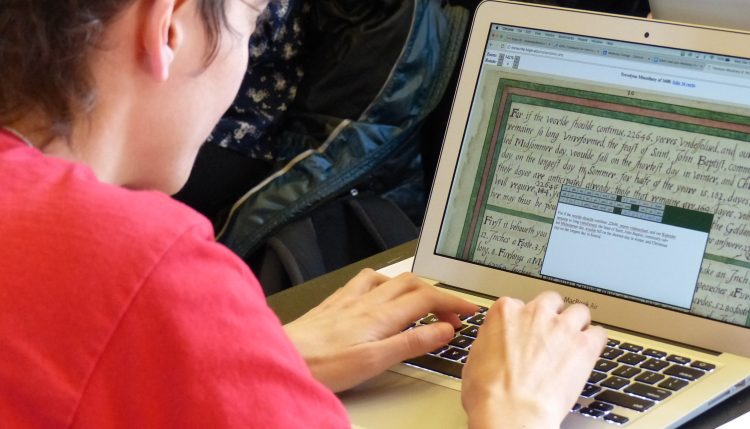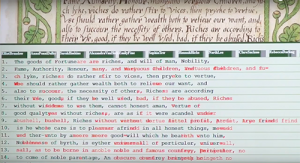
Transcribathon of An Early Modern Manuscript
“I think that’s a ‘1’, not an ‘I’.”
“Does this look like ‘yeeare’… or ‘ye eare’?”
For five hours on March 8, 2017, transcribers buzzed and muttered as they bent over laptops. They were transcribing and encoding an early 17th century manuscript, the heavily illustrated Trevelyon Miscellany of 1608. Their work would eventually become part of a large-scale public digital humanities resource, the Folger Shakespeare Library’s Early Modern Manuscripts Online (full site now available in beta form at: http://emmo.folger.edu/).
This was the Transcribathon, a unique event for Wellesley College, who welcomed Heather Wolfe, Curator of Manuscripts at the Folger, and Paul Dingman, Project Manager for EMMO, to provide a brief introduction to the process of transcription using the Folger’s tool, Dromio.
Once oriented to the manuscript and the transcription guidelines, participants picked a manuscript page and began transcribing what was written.
Many of the about 50 participants, who were a mix of students, faculty, and staff from Wellesley and other Boston-area institutions, had had no previous instruction in paleography or interpreting early modern manuscripts. While the Trevelyon Miscellany is written in a relatively easy (for modern readers) italic hand rather than the more unfamiliar secretary hand, there were still plenty of instances of idiosyncratic spelling, obscure abbreviations, and illegible portions. With expert and novice paleographers working alongside one another, there were opportunities to confer and learn.
Students rarely get training in paleography or interact with manuscripts at the undergraduate level. Key elements of the interpretation of an early modern text can be lost when a student is presented with a text-only format, frequently in digital form, that is divorced from its material manuscript context. This was the Folger’s first transcribathon at a liberal arts college (previous EMMO transcribathons had been held at University of Pennsylvania, University of Connecticut, University of Michigan, University of Virginia, University of South Carolina, and Virginia Commonwealth University). This event, developed as part of Wellesley’s Andrew W. Mellon Blended Learning Initiative, gave two Wellesley classes–Ruth Rogers’ History of the Book course (ARTH 299) and Sarah Wall-Randell’s Nonbinary Gender on the Renaissance Stage course (ENG 325)–the opportunity to engage in the editorial practice of interpreting and transcribing early modern writing. While students in these classes were key participants in the Transcribathon, the event was open to all who wanted to learn and contribute, and about half of the participants were from outside the courses.
Transcription is an activity that requires deep engagement with primary sources, but many also found it addictive, staying much longer than they originally meant to. “They treat it like a game or a puzzle,” said Dr. Heather Wolfe, “you might have to skip a word because you can’t make it out right away…and then you transcribe a little bit more…and then you go back, and aha! You figure out what it is. It’s very satisfying.”
At 3pm, the participants readied at their individual machines for a exercise in competitive transcription. A single page was revealed to the transcribers, and for three minutes, the participants transcribed as many lines of text, with as few mistakes, as possible.
Using Dromio’s collation feature, which overlays the transcriptions from all participants and highlights areas of disagreement in red, we reviewed the lines transcribed as a group. Ten points were awarded (on the honor system) for each completed line, and one point deducted for each transcription error. While we awarded prizes for the top transcribers, the most fun and interest came from seeing how individual transcriptions could be reconciled by an expert paleographer into a single transcription of the manuscript.
It’s easy to imagine this activity taking place in a classroom, where students and faculty can discuss their interpretations of a text.
After five hours of group transcription, the fifty Transcribathon participants had transcribed an impressive 193 pages of the Trevelyon Miscellany. The overwhelming reaction to the event was “when can we have another?”
To see more of the Wellesley Transcribathon, watch the video below.
Many thanks to the Andrew W. Mellon Blended Learning Initiative and the Committee for Lectures and Cultural Events (The Baum Fund) for their support, and to Dr. Heather Wolfe, Curator of Manuscripts at the Folger Shakespeare Library and Paul Dingman, Project Manager for EMMO, for their expert guidance.



